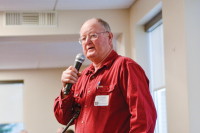A health care coverage crisis is unfolding at Canton’s paper mill
That the American health care coverage system is broken shouldn’t come as a shock to anyone, even proponents of the 2010 Affordable Care Act who thought Obamacare would make coverage affordable for everyone. But as long as workers with employer-subsidized health care are forced to rely on the generosity of capitalists for their health and well-being, there will continue to be crises like the one currently unfolding with soon-to-be unemployed workers at Pactiv-Evergreen’s Haywood County facilities.
A modest proposal for Medicare
By Steven Wall • Guest Columnist | With so much division in our country, and some folks even losing faith in democratic government, I would like to offer a proposal concerning Medicare. I do this in the hope that such a proposal if implemented could help restore some faith in government.
Hospitals, BCBS renegotiating Medicare Advantage plans
Unless a new agreement is signed, patients with Blue Cross, Blue Shield Medicare Advantage Plans will have to pay out-of-network prices for services at Duke LifePoint hospitals beginning Jan. 1, 2021.
Increasing Medicare coverage could lower healthcare costs
 By Martin Dyckman • Guest Columnist
By Martin Dyckman • Guest Columnist
The United States spends twice as much on health care as most other modern nations, with less to show for it in terms of longevity and other true measures of health. The reasons why — and what we could and should do about it — make the March 4 edition of TIME probably the most important single issue of any magazine ever published.
Steven Brill’s cover story, “Why Medical Bills Are Killing Us,” takes up nearly the entire edition. Anyone who cares about this — and who doesn’t — needs to buy or borrow the magazine now or download the article from TIME’s website. It’s a keeper.
MedWest leadership shuffle gives hospitals more autonomy
Concerns among Jackson County doctors that Harris Regional Hospital is not thriving as it should under a partnership with Haywood Regional Medical Center has prompted a change in top leadership.
Harris once more has its own CEO, and Haywood will be under its own CEO. This marks a step back from the shared management structure the hospitals were moving toward.
“Right now, it is clear that we need to have two very strong managers focusing on their specific campuses,” said Fred Alexander, chair of the MedWest Board of Directors, the umbrella partnership for the Haywood, Jackson and Swain county hospitals.
Until last week, Mike Poore served as the CEO of all three hospitals as well as the umbrella partnership of MedWest. Poore has now been pulled back to his former role of being over Haywood’s hospital only. WestCare, which includes both Harris and Swain County Hospital, will have its own CEO in Steve Heatherly, who was second in command at WestCare prior to the partnership and since then has served the head of the MedWest Physician Network, which employs more than 80 doctors.
Poore said he wants whatever is in the best interest of all three hospitals, even if that means a change in his job title.
“We have to be laser focused on giving the absolute best care at each of our hospitals,” Poore said.
When Harris and Haywood hospitals formed a partnership two years ago, the CEOs of both applied for the top job over the new MedWest entity. While Haywood was seen as pulling for Poore, Jackson was seen as pulling for its own CEO at the time, Mark Leonard. When Leonard did not get the top spot, he left rather than staying on in some other capacity.
Now, Heatherly may be the next best thing. He has been at Harris since 1997, working his way up to CFO, chief operating officer and executive vice-president. Heatherly got his MBA from Western Carolina University.
Alexander said several physicians recently brought their concerns about the direction of Harris to the hospital’s board and management team.
“I think their sincere motivation is to try to see the hospital operating more smoothly,” Alexander said. “As a result we felt both hospitals needed to have direct hands-on management. Our whole desire is to resolve any issue that is present.”
And the clock may be ticking. If Jackson’s medical community isn’t satisfied, they could lobby to pull out of the MedWest partnership in 2013.
While dissolving the partnership may not be particularly easy, there was a clause in the contract forming MedWest that allowed for an out after three years — which is coming up next year. But it would take a super majority of MedWest’s board of directors to terminate the partnership. The board has 14 members — with Haywood and WestCare evenly represented with seven members each — and 75 percent would have to vote to dissolve. Barring that, legal arbitration could be an option.
Not uncommon hiccup
In addition to partnering under the MedWest umbrella, the entity also signed a management contract with Carolinas Health System, a network of 30 hospitals under the flagship Carolinas Medical in Charlotte.
Carolinas Health System has been an astute observer in recent years of mergers and partnerships playing out with smaller hospitals across the state. Hiccups like this are not uncommon, according to John Young, vice president for Carolinas HealthCare’s western region.
“We need someone living and breathing and spending all their time on each side,” Young said. “When you have people going back and forth you feel like nobody is getting the full attention of anybody. We decided it was time to make sure we had enough boots on the ground in terms of leadership.”
Neither hospital has a particularly easy row to hoe these days — whether together or alone. Hospitals and doctors have all been impacted by the recession, as consumers cut back on health care spending and insurance companies and Medicare lower their reimbursement rates.
But the financial challenges in Haywood and Jackson have been exacerbated by competition from Mission Hospital, which has been chipping away at market share of the local hospitals in recent years.
“We have lost too many patients out of our marketplace and that is putting financial stress on the entire organization,” Young said. “If we get grow bigger and get better a lot of this stuff will just fall away.”
The MedWest partnership is still relatively new, and there is naturally going to be an adjustment period as hospitals and doctors who used to be independent begin thinking collectively, Young said.
“We probably are moving it back a little bit form the direction we were going, but if that helps both sides be more successful, then it will help MedWest be successful,” Young said.
As the CEO of all three hospitals and MedWest at large, Poore brought a more collective approach that perhaps the hospitals and medical communities weren’t ready for yet.
“We haven’t been meticulous about accounting this widget went to that campus and that widget went to that campus, but we are going to start doing that,” Poore said.
Several administration functions have been consolidated by the partnership. MedWest shares a nutrition department, marketing department and purchasing department, for example.
But medical care and health specialties have not been consolidated, and there are no plans to make patients trek to either-or hospital depending on the type of treatment they need.
“The end game of everything we are trying to do through MedWest and the individual hospitals is to provide local services for local people,” Alexander said.
Alexander pointed out that if the business side of a hospital — namely how good or bad the hospital is faring — always seems to capture headlines, that’s because it is directly related to its mission.
“Most succinctly, if a hospital wants to do good for its community it must do well financially,” Alexander said.
Alexander said the hospitals may return to a single CEO model at some point.
“We don’t see this as a permanent set up, but for the foreseeable future,” Alexander said. “Change is your middle name if you are a hospital these days. In the life cycle for any organization the form has to follow the functions that are at hand.”
County health rankings yield mixed results
But this year, an unprecedented study compiled health rankings for every county in each state across the country.
The results weren’t good news for Swain County, which ranked in the bottom 10 percent in several categories. However, Haywood, Jackson and Macon counties went against the stereotype of poor health in the Appalachian Mountains and ranked in the top third.
“The western part of the state is a good deal older. When you control for that, the east part of the state seems a good deal unhealthier,” said Dr. Tom Ricketts, past director of the North Carolina Rural Health Research Program at the University of North Carolina at Chapel Hill.
Compiled by the University of Wisconsin, the study divided heath rankings into two broad categories: health outcomes and the health factors that cause them.
Swain County ranked 91st out of 100 counties in the state — the lowest ranking of any county in WNC when it comes to health factors. Meanwhile, Jackson, Haywood and Macon Counties are ranked in the healthiest third at 31, 19 and 15 respectively.
Diet, smoking, drinking, exercise, access to quality health care, social and economic factors, and the physical environment all play into the ranking.
“Health and health behaviors and care are all tangled up in a multi-complex system,” said William Aldis, a World Health Organization representative to Thailand who lives in Sylva and has taught health classes at Western Carolina University and at a university in Thailand. “You can never completely separate these things.”
Aldis said he notices the difference in health as soon as he steps off the plane and into the airport terminal when he returns to the United States.
“It surprises me when I come back how sick people look here compared to other countries,” he said.
While the University of Wisconsin study took on an enormous task, the rankings are not universally accepted by public health officials.
Linda White, director of the Swain County Health Department, has not used the information in any strategic planning because she thinks the data may be skewed.
She often compares Swain to Graham County in her planning because the populations are similar. But she noticed the study reported Swain to have the highest percent of smokers in the state while failing to report a percentage of smokers in Graham.
“It causes me to question the validity of the data,” White said.
Macon County Health Director Jim Bruckner said some counties may need to look harder at some of the statistics to determine their quality because of the sampling methods. But Bruckner said the health department has a lot it can glean from the statistics.
Every three years, the health department uses a variety of statistics to create a “snapshot” of health outcomes and contributing factors in Macon County. Bruckner said the county health rankings will now be included in the project.
“We hope to use this report to shed light on what more we can do to help residents lead healthier lives and to mobilize community leaders to invest in programs and policy changes that will improve Macon County’s health,” Bruckner said.
Health behaviors
The University of Wisconsin study looked at key health behaviors — which will ultimately affect people’s health in the future — such as diet and exercise, tobacco use, unsafe sex and alcohol use.
The study uses obesity as the measure for a county’s commitment to diet and exercise. Although obesity is a problem across the state, Jackson, Macon, Haywood and Swain Counties are no worse than the state average, according to the County Health Rankings.
North Carolina is the 10th most obese state in the nation with an adult obesity rate of 29 percent, according to the Trust for America’s Health “F as in Fat” 2010 report.
And North Carolina has grown heavier. In 2009, North Carolina was the 12th most obese state, 16th in 2008 and 17th in 2007.
“Obesity is one of the most challenging issues and has had the more lasting impact on our society,” said Carmine Rocco, Haywood County Health Department director.
Reducing childhood obesity is a big focus for health departments in Western North Carolina.
“We’ve attempted to combat that for years,” White said. “It’s a lifestyle change. Kids will eat what’s offered to them.”
White has worked with schools in Swain County to get healthier food on the menu. Between five and six years ago, the health departments removed the deep fryers from the school cafeterias and purchased them ovens instead, White said.
But it’s other health behaviors that earned Swain County its low ranking. Swain has the highest percentage of smokers in the state and one of the highest teen birth rates, which is used to indicate unsafe sex tendencies.
Dr. Mark Engel, a family doctor in Swain County, said he thinks part of the problem with Swain’s health is that preventative care has not been emphasized until recently and that Swain has been more isolated than the counties to the east.
“Swain has been socially isolated long enough,” Engel said. “It will be an uphill climb for better health.”
He’s noticed higher social support for both smoking and teen pregnancy, he said, adding that it will take generations to change the population’s attitudes.
Forty percent of adults in Swain County smoke compared to 23 percent across the state.
“We’ve come leaps and bounds,” White said, who questioned the accuracy of the statistics. “We work on lessening those numbers regardless of what they are.”
Both Dr. John Stringfield and Dr. Michael Brown, who are family doctors in Waynesville, said that they’ve seen a decrease in the number of smokers in their offices even though the study reports that Haywood still has a higher percent of smokers compared to the state average.
“There’s been an increase in education and peer pressure against smoking,” Brown said.
Only Macon County with 19 percent of the population being smokers falls below the state average.
Ricketts said that there is a strong correlation between smokers and more rural environments. He suggested that smoking might be a form of entertainment where few other options exist.
“It’s hard to explain,” Ricketts said. “It just is.”
Clinical care
Another key component in assessing an area’s health is the availability of healthcare. Researchers at the University of Wisconsin examined several factors, including the percent of uninsured adults, the number of primary providers in the area and preventable hospital stays.
Jackson and Swain Counties have poor clinical care rankings at 86 and 93 respectively while Haywood and Macon Counties are both in the top 15, according to the study.
“In the early ‘70s, the main problem was that there’s been a misdistribution between urban and rural areas with primary care physicians,” said John Price, director of the N.C. Office of Rural Health and Community Care. “The issue over the years has changed a little. The issue is economic access to care.”
Three of the four counties — with Haywood being the exception — have more than 22 percent of adults without health insurance.
That portion is noticeably higher compared to about 15 percent of American and 17 percent North Carolinians who are uninsured.
The Good Samaritan Clinic in Jackson County is a free clinic that treats uninsured adults. A volunteer doctor at the clinic, Dr. David Trigg, said there are often misconceptions about who the uninsured are.
“They’re not unemployed. They’re just uninsured, and they certainly aren’t lazy,” he said,
But in the clinical care rankings, other factors have a role in bringing down Jackson and Swain counties’ rankings.
Swain County has a high rate of hospitalization for typical outpatient services, according to the study. This suggests that outpatient care in the area is less than ideal or that the people overuse the hospital as the primary source of care, the researchers wrote.
A strike against Jackson County’s ranking is a low percentage of diabetic Medicare patients getting annual blood sugar control tests. The tests are considered a standard of good healthcare — a standard at which Jackson is the lowest in the state.
“One reason that could be lower is the way it’s recorded,” said Paula Carden, the Jackson County Health Department director. “Whether all the numbers get reported or not is hard to say.”
Carden said doctors are responsible for reporting the screenings when their patients come to get them. The codes used by doctors in Jackson to report the data may be different from those in other counties.
In one aspect of clinical care, the number of primary care doctors per capita, the study found all four counties at or above average.
But some of the physicians are counted twice, inflating the number of doctors for Western North Carolina. Many doctors in Jackson, Macon and Swain counties practice across countylines — with their main office in one county but a satellite office in the other where they hold weekly office hours. These doctors appear to be counted in both counties.
“Even if there are enough providers to the population by the numbers and they appear at the right levels, they’re not,” Good Samaritan Clinic director Becky Olson said. “The problem is that Jackson County doctors don’t just serve Jackson County alone.”
The study also fails to take into account the influx of seasonal residents and tourists to the area. Doctors in Western North Carolina said they can tell when the part-time residents begin to arrive in the spring.
“It’s an elusive number, hard to quantify,” said the Haywood County Health Department director Carmine Rocco. “But it’s a reality we have to deal with when we plan health care. If something happens, we have to be able to respond.”
Flu and respiratory illnesses keep his schedule filled during the winter, and during the summer, he sees an influx of seasonal residents. Some older residents who come for four or five months in the spring and summer have chronic conditions that require a physician’s monitoring, said Dr. John Stringfield, a doctor at Waynesville Family Practice.
“What keeps me busy is different for each season of the year,” he said.
But Ricketts said he wouldn’t call seasonal homeowners or tourists a stress on the Western North Carolina healthcare system.
“For a rural place, it generally does pretty well on physician supply,” Ricketts said.
He gave the motorcycle rally in Sturgis, S.D., as an example of something that would cause stress on the system. In 2008, the rally brought more than 400,000 bikers and three rally related deaths to the small town.
“[Tourism in Western North Carolina] doesn’t necessarily provide stress but provides income,” Ricketts said.
Social & economic factors
Research has shown that social and economic factors also play a key role in determining health.
“To have an overall picture of health, it’s affected by economic factors,” health director Carden said. “If you don’t have enough money for the good health care, your overall health is affected. … Economics plays an important role in our overall health whether we like it or not.”
According to the University of Wisconsin study, Swain County has the lowest high school graduation rate, fewest college degrees, highest unemployment and most single-parent households compared to the other three counties.
“More educated people are in a much better position to analyze health choices,” Aldis said. “Education is a powerful tool in expanding people’s health choices.”
Aldis said that in his work in foreign countries where the populations are less literate than in the United States, women who can read are more likely to get their children vaccinated even if they haven’t had any medical training.
But even less educated patients are attentive and willing to learn how to make better health choices, Trigg said about his patients at the free clinic. But without the clinic, they don’t have the same knowhow about getting health information, he said.
“They don’t get on the Internet and look up health information the same way someone from the university would,” he said.
Hand-in-hand with education, poverty also limits a people’s health options in that they can’t afford the best or at times adequate care, said Stringfield, a Haywood doctor.
“Those in a lower social economic status may tend to have more medical problems,” Stringfield said. “Sometimes that has to do with access to care or access to medicine. Many simply can’t afford to fill a prescription.”
Poverty also influences people’s food choices. Fruits and vegetables are expensive compared to a value menu at the local fast food restaurant. Snack food is also cheaper but contains unhealthy ingredients such as excess salt and high fructose corn syrup, Aldis said.
“There’s not a sense of autonomy of choice,” he said. “We have a very interesting inversion going on. Obesity is a disease of the poor.”
To learn more, visit www.countyhealthrankings.org/north-carolina.
How WNC stacks up
The University of Wisconsin ranked all counties in all states by health outcomes and health factors. Within health factors, four subcategories determined the rankings: health behaviors (30 percent), clinical care (20 percent), social and economic factors (40 percent), and physical environment (10 percent).
There are 100 counties in North Carolina. A ranking of 1 would denote the healthiest county while 100 would signify the unhealthiest in that category.
Health Factor Rankings denotes overall health. The others show what went into determining the rankings.
Health Factors Rankings
Macon 15
Haywood 19
Jackson 31
Swain 91
Health Behaviors Rankings
Macon 12
Haywood 35
Jackson 39
Swain 97
Clinical Care Rankings
Haywood 11
Macon 14
Jackson 86
Swain 93
Social and Economic Factors Rankings
Haywood 16
Jackson 19
Macon 33
Swain 79
Physical Environment Rankings
Swain 14
Jackson 35
Macon 51
Haywood 72
Percentage of Smokers
Macon: 19%
Haywood 27%
Jackson 28%
Swain 40%
State Average 23%
At free clinics survival trumps politics
Dr. David Trigg, medical director at the Good Samaritan Clinic of Jackson County, doesn’t know if he should do more or less to treat the uninsured. While he and the other volunteer doctors at free clinics are their patients’ only option for health care, he sometimes feels they’re the ones propping up a broken system.
“You feel like the boy with his finger in the dyke,” Trigg said. “Not only is it not the solution to the problem, but it paralyzes you. But don’t tell our patients that. They don’t have any alternative.”
Trigg has seen the failure of health care for the poor from a number of angles. As an emergency room doctor who currently works part-time intermittent shifts in Cherokee, he has seen the way uninsured chronic care patients clog the country’s critical care facilities.
“The ER is the safety net for people who don’t have insurance, and it’s not sustainable,” Trigg said. “If emergency rooms keep getting busier, not only will the poor suffer because they’ll continue to get boarded, but the rich will begin to suffer because they’ll be so inundated they won’t get to the critical cases,” said Trigg.
As a volunteer primary care provider at a free clinic, he has seen how people without insurance work to get better, to work some more to pay their bills, without ever having any real hope of getting insured.
“The patients will break your heart. Let’s talk about a man who works three jobs and his employers deliberately won’t give him 40 hours per week so they don’t have to provide insurance,” said Trigg.
As a teaching doctor at Western Carolina University’s health science program, he has seen how the insurance reimbursement system discourages doctors from going into primary care, creating shortages.
“Part of reform has to be — not debt forgiveness — but scholarships for doctors who go into primary care,” said Trigg. “I think a lot of young people would go a year for a year. You have to pay primary care providers more and specialists less.”
For Trigg, the fact that North Carolina has 77 free clinics — the most in the nation — is neither an indictment nor a credit. It’s a reality.
“Anytime someone gets into the free clinic, they realize — consciously or subconsciously — that the system is broken. They’re not necessarily politically motivated though because they’re in survival mode,” said Trigg.
Trigg thinks part of the reason the debate over health care is so contentious is because the people who know the system is broken are too disillusioned to join the discussion.
In many ways, the health care debate is as simple as the separation between rich and poor, and the poor don’t often tell their own story as well as others tell it for them.
Becky Olson, Good Samaritan Clinic of Jackson County’s executive director, said her impression of the clinic’s patients is they don’t believe their government listens to them, so they don’t bother speaking to it.
“What I do feel and see here is a real sense of disenfranchisement,” Olson said. “I’m not sure how many of our patients vote because there is a feeling it wouldn’t make a difference. The real voices in this discussion on both sides are coming from people who don’t have to worry in the same way about where their health care comes from.”
Olson, a registered nurse who has spent the last 30 years working in a variety of settings from labor and delivery to long-term care, began volunteering at Good Samaritan when the free clinic opened in 2001 and became executive director in 2006. She is increasingly frustrated that health care has become a politicized discussion about costs, when the human cost of failing to provide affordable health care is decimating people’s lives and increasing the gap between rich and poor.
“The bottom line right now is it’s not working for a significant part of the population,” Olson said. “I haven’t heard anyone who can say with certainty how much it might cost or how much it might save to change the system.”
For Olson the issue is simple. The patients she sees everyday shouldn’t have to wait in lines at free clinics to get treated for everyday health issues like asthma, diabetes, hypertension, and back pain.
“This is not the way that health care ought to be gotten. If our clients had a better way into the system, we would with great pleasure close the doors,” Olson said.
For a long time, health care providers stayed out of the debate over health care policy. In general, doctors and nurses are practical people focused on their work, but Olson has grown increasingly exasperated by the argument that the government shouldn’t pay to provide care to the poor.
“That kind of argument ... if you don’t think the government should be running programs for poor folks, then maybe you shouldn’t take Medicare,” Olson said.
When insurance falls short, out-of-pocket costs become rapidly out-of-reach
As if dealing with the trauma of breast cancer wasn’t enough, Martha Yonce, 62, was also hit with a devastating $80,000 in out-of-pocket expenses for her surgery, chemotherapy and radiation.
Yonce, a Franklin resident, thought she had her bases covered with the equivalent of a state employee’s health insurance policy. She received the insurance through her husband, who was a science teacher at Macon Middle School at the time.
Yonce’s insurance company had agreed to pay 80 percent of the cost but left her to deal with the remaining 20 percent in whatever way she could.
Coming up with such a large sum of money proved to be a major struggle, as Yonce and her family neared the brink of bankruptcy and almost lost their home.
“We wiped out what savings we had,” Yonce said. “It just took everything we had. That was nine years ago, and we’ve never really recovered financially.”
To make matters even worse, Yonce and her husband were recently denied insurance coverage that would supplement Medicare due to pre-existing conditions, including her breast cancer, and his diabetes and heart problems.
Even though Yonce has been cancer-free for years, she said the worry about recurrence never goes away.
“Good days are days you don’t think about cancer,” said Yonce. “You know that if it recurs, you are going to have a tremendous financial burden. You’re going to do all you can to save your life and treatment costs money — even with insurance.”
Yonce said she recalled taking medication for nausea that cost $100 a pill, while other women went without because they simply could not afford it.
“The thought of somebody that’s kneeling at the toilet vomiting and there’s a medication out there that can help them and they can’t afford it, that’s sad, that really is,” said Yonce, who has actively been calling for health care reform in the past year.
Yonce has attended rallies and made frequent calls to representatives and fellow citizens in the past few months. She hopes that Congress will pass a health care bill that places a cap on out of pocket expenses.
Yonce said she was surprised by how many sad stories she came across while working at a phone bank. She once talked to a man who was asked to pay $900 cash for anti-rejection medication after receiving a kidney transplant and a woman who broke her hip but could not afford to go to the hospital.
Despite all the gloomy stories she’s heard, Yonce has managed to retain a sense of humor.
On a recent afternoon, Yonce prepared to go door-to-door to distribute flyers that featured a man named Vernon whose inadequate health insurance left him $28,000 in debt.
“This guy is not in as bad shape as me,” joked Yonce. “Vernon, you don’t know how good you’ve got it.”
When the health care crisis hits home: Three sisters share stories of insurance illusions
Nothing could have prepared Franklin sisters Suzanne Thomas and Karen Rice for the total financial ruin that followed their injuries.
Thomas, 63, and Rice, 70, are still coping with the impact of astronomical medical costs from nearly a decade ago, while another sister Shirley Ches, 74, is dealing with a health insurance bill that already scoops up about 33 percent of her household income and continues to climb significantly each year.
Thomas had to file for bankruptcy, while Rice had to move into a mobile home, giving up electricity and washing machines in the meantime. What astonished the sisters most about their plight was that they both had what they considered good health insurance when their injuries occurred.
Ches, Rice and Thomas have channeled the anger and frustration of their experience into an active fight for healthcare reform across the country, helping to organize vigils, sending petitions to Washington and sharing their story with crowds of strangers.
“We have all made a career out of writing letters to the editor,” said Ches.
Through their activism, the sisters have realized they are far from alone in their hardships.
“When you go to these things, you find people with phenomenal stories,” said Ches. “We’re shoulder to shoulder with so many people.”
Losing it all
Thomas had been perfectly happy with her health insurance before she suffered a major shoulder injury due to a fall in 2000.
“I had wonderful insurance. I didn’t worry about a thing,” said Thomas, who never hesitated to visit the doctor, the dentist or optometrist.
Two years later, Thomas had not only lost that health insurance, but also her job, her home and her good credit. Thomas had to file for bankruptcy and move from her two-bedroom apartment in rural Michigan to Ches’s home in Franklin about seven years ago.
It was all the result of a ruptured spleen that doctors didn’t even discover until two days after her accident. Thomas had complained about stomach pain, but her doctors wrote it off as a side effect of her pain medication and sent her home to await shoulder surgery.
Thomas began throwing up frequently and continued to suffer excruciating pain. Her friends decided to rush her back to the hospital as she floated in and out of consciousness.
After making the 32-mile ambulance trip to the hospital, Thomas summoned up enough strength to sign off for the splenectomy surgeons said she needed to stop her internal bleeding.
Along with the splenectomy, Thomas had five surgeries on her arm, and physical and occupational therapy over the next year and a half. Her hospital stay alone rang up $35,000.
When the time to pay the medical bills rolled around, the insurance company refused to pay for the splenectomy — Thomas had never gotten pre-approval for it.
Thomas was appalled that the insurance company expected her to give them a ring during the emergency ambulance transport.
“I was half-dead,” said Thomas.
Thomas couldn’t work her full-time job as she recovered, so she ended up losing her health insurance along with her job.
“You can only do Cobra for so long and afford it,” said Thomas.
Though Thomas tried to take on spot jobs, including a stint harvesting grapes with her non-dominant hand during Michigan’s chilly fall, she could not make enough to keep up with her monthly bills.
At one point, Thomas had to run outside as a tow truck began to pull away with her repossessed car to salvage all her belongings from the vehicle.
At a time when just getting dressed proved to be a struggle, Thomas had to deal with a steady stream of hospital bills and an unsuccessful legal battle to appeal the charges. Thomas had no recourse but to file for bankruptcy and move into Ches’s basement apartment.
According to Thomas, most people in the U.S. are not immune from suffering the same ordeal.
“I paid my bills. I had good credit,“ sad Thomas. “Yes, you have a job right now. Yes, you have health insurance right now, but ... maybe you’re going to end up having to pay.”
Thomas currently works as a cashier at Harrah’s Casino in Cherokee, mostly because the job provides health insurance.
“I never thought I would be working at this age,” Thomas said.
Extreme sacrifices
Because of her own shoulder injury, Rice now finds herself living in a single-wide mobile home in Franklin.
After several months of physical therapy and doctor’s visits, Rice had to pay between $25,000 and $30,000 in out-of-pocket expenses.
Rice said she checked in with the insurance company each time she went to the doctor’s office to make sure she had enough coverage. It turned out her insurance company had not yet processed her bills, so they were not aware her coverage had already run out.
“I would have said ‘Look, I’m running out of money. I will settle for a certain level of disability, find an alternative source of treatment I can afford, or save up until I can afford to continue,’” said Rice.
Instead, Rice had to sell her 200,000-square-foot home and move to a single-wide trailer in Franklin to be closer to her two sisters and save up for the “next healthcare disaster,” Rice said.
Rice, who said she always paid her bills on time and never carried credit card balances, saw her credit ruined since she couldn’t keep up with medical payments.
But Rice decided to take a proactive approach after that financial catastrophe.
Rice slashed every expense that she could, using candles instead of electricity and washing all her clothes by hand. She stopped traveling to see her children and no longer sent them any gifts. Rice consolidated trips to the grocery store, going only every two or three weeks, to save on gas.
“If it wasn’t something I absolutely needed to survive, I didn’t spend the money,” said Rice, who didn’t meet her youngest grandson until he was three years old and came to the area to attend Rice’s husband’s funeral.
Now that Rice believes she’s saved up enough of a cushion, she has started using electricity again, though she continues to wash her clothes by hand.
Rice hopes the money she has saved will be sufficient to cover her future medical costs without relying on others.
“All seniors are afraid that we’re one disaster away from ruin,” said Rice. “I do not want to be a burden on my neighbors, friends, church and society.”
Rice said she had previously been ashamed about her financial turmoil, wondering what she could have possibly done wrong. But she decided to share her story because many others were experiencing similar predicaments.
“I’m not alone. I’m not unique,” said Rice. “That’s the sad part about it.”
Rice said she does not want health care reform for just her or her sisters.
“We want this for others, our children and grandchildren, for everyone,” said Rice.
A broken system
Ches said she and her husband are being punished unfairly for simply growing one year older. Her insurance costs have gone up by 15 percent this year.
“It has gone up for no reason,” said Ches. “We have not been sick. We haven’t even used the amount of money that we’ve paid into it.”
Ches wonders what will happen if she has a medical emergency like those her sisters experienced.
“We’ll join the mob in the emergency room,” said Ches. “Then, all the people currently have health insurance will be impacted negatively.”
After having such a terrible experience with the American health care system, the three sisters feel very strongly about passing health care reform.
“The people who have insurance don’t realize that they can lose it,” said Rice. “The people who have insurance are very happy with the status quo.”
The sisters say those who are sick should not be spending their time wondering about how they would pay for treatment.
“I think something is really broken here,” said Rice. “I have to be afraid to spend a penny because I’m afraid of a medical emergency.”
Ches said those who receive health insurance through their employer and believe they are safe from similar scenarios are living in a “fool’s paradise.”
“You have employer subsidized insurance until you are out of work,” said Ches.
According to Rice, the U.S. must ultimately come up with its own solution rather than following how other countries run their health care system.
Though all three sisters say they would like to see a single-payer system, Rice said she has had “wonderful conversations” and found common ground with those who oppose exactly what she supports.
“Fox, CNN, MSNBC – I watch all of them. I will listen to all sides, the truth is somewhere in between,” said Rice, who is disappointed that the health care debate has taken such an ugly turn.
“This should not have become a partisan issue, the people need to realize that,” Rice said.









